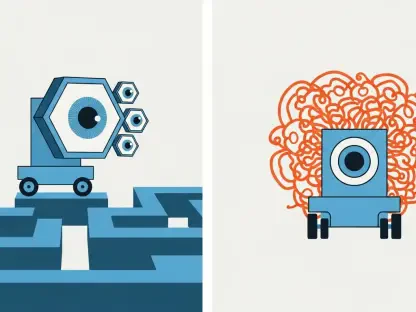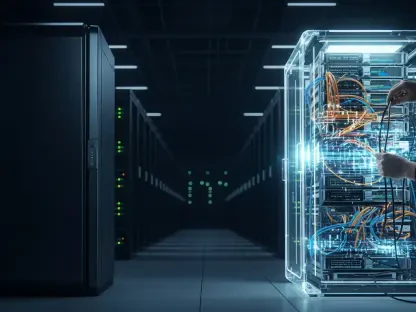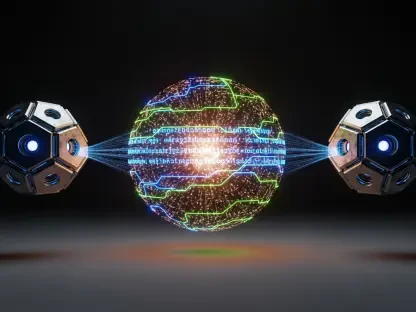Laurent Giraid, a seasoned expert in artificial intelligence with deep insights into machine learning, natural language processing, and AI ethics, shares his perspectives on Google’s ambitious strategies in the AI and cloud computing realms. This interview delves into the transformative technologies and challenging obstacles surfacing in the field, offering a closer look at how Google is positioning itself against formidable competitors like Microsoft and Amazon.
How is Google Cloud positioning itself in the competitive landscape of AI?
Google Cloud is taking a very aggressive stance, especially with a sweeping array of new technologies aimed at what they call “thinking models.” They are focusing on specialized infrastructure and comprehensive AI-optimized platforms to solidify their position. The emphasis is not just on developing sophisticated AI systems but also on making these technologies accessible and efficient for a wide range of enterprises.
What are the key areas of focus for Google Cloud in its AI strategy?
The main focus areas are around enhancing computational power with new TPU generations, expanding their AI models’ capabilities, and developing a multi-agent ecosystem. Google is also keen on efficiency – both in terms of computing power and energy consumption – as well as interoperability, which means enabling different AI systems and tools to work together seamlessly.
Can you explain the significance of the seventh-generation Tensor Processing Unit, Ironwood?
Ironwood represents a major leap in Google’s TPU technology. It’s designed specifically for running complex AI models after they’ve been trained, which prioritizes inference over training. This makes a huge difference in real-world applications where latency and efficiency are critical.
How does Ironwood differ from previous generations of TPUs?
Unlike previous generations that balanced between training and inference, Ironwood is optimized solely for inference. This means it offers more power and better operational efficiency for running complex AI models. In practice, this translates to faster and more efficient real-time data processing.
What kind of computational power does Ironwood deliver?
Ironwood delivers an astonishing 42 exaflops of computing power per pod. To put that into perspective, it is 24 times more powerful than the world’s leading supercomputer, which signifies a monumental advance in computational capabilities.
How does Ironwood improve power efficiency compared to previous generations?
The Ironwood TPUs are reported to be twice as power-efficient as their predecessors. This is crucial because one of the biggest challenges with generative AI is its high energy consumption. More efficient models require less energy to operate, making them more sustainable.
How important is energy efficiency in the context of AI computing?
Energy efficiency is becoming increasingly critical in AI computing. High energy consumption doesn’t just translate to higher operational costs; it’s also a significant environmental concern. Efficient computing not only saves costs but also makes AI technologies more sustainable in the long run.
What is Cloud WAN and how does it benefit enterprise customers?
Cloud WAN is Google’s service that opens up its extensive global network infrastructure to enterprise customers. Essentially, it allows businesses to utilize Google’s 2-million-mile fiber network, the same network that powers services like YouTube and Gmail. This results in improved network performance and reduced operational costs.
How does Cloud WAN enhance network performance and reduce costs?
Cloud WAN improves network performance by up to 40% and reduces the total cost of ownership by the same margin, compared to customer-managed networks. By leveraging Google’s vast infrastructure, businesses can achieve these gains without the need for extensive in-house resources.
What is the Gemini model family and what advancements does Gemini 2.5 bring?
The Gemini model family showcases Google’s advanced AI systems, including Gemini 2.5, which incorporates “thinking capabilities.” These models can tackle complex problems more effectively by using multi-step reasoning and self-reflection, which is a significant improvement over traditional models that generate direct responses.
How do the “thinking capabilities” of Gemini 2.5 improve over traditional large language models?
Gemini 2.5 stands out by breaking down complex problems through multi-step reasoning, allowing deeper analysis and more accurate solutions. Traditional models often provide straightforward answers, while Gemini 2.5 engages in a form of self-reflection, making its problem-solving approach more advanced and nuanced.
What are Gemini 2.5’s high-complexity use cases?
Some of the high-complexity use cases for Gemini 2.5 include drug discovery and financial modeling. These fields require handling vast amounts of data and intricate problem-solving processes, which the advanced capabilities of Gemini 2.5 are well suited for.
How is Google expanding its generative media capabilities with tools like Imagen, Veo, Chirp, and Lyria?
Google is broadening its generative media technologies with updates to tools like Imagen for image generation, Veo for video, Chirp for audio, and the new Lyria for text-to-music creation. These tools can be integrated to produce comprehensive multimedia content, making them valuable for creative industries.
Can you provide examples of how these tools can be used together in practical applications?
Absolutely. For instance, in marketing, these tools can be used to create a promotional video for a concert. Imagen could generate images for the flyer, Veo could produce the video, Chirp could add audio, and Lyria could compose custom background music, all synthesized to deliver a compelling promotional package.
What is a “multi-agent ecosystem” and why is it important for enterprises?
A “multi-agent ecosystem” refers to an environment where different AI systems work together seamlessly. This collaboration between multiple agents can improve operational efficiencies and create smarter, more versatile applications. For enterprises, it means integrating various AI functionalities to solve more complex problems.
Can you explain the purpose and functionality of the Agent Development Kit (ADK)?
The ADK is designed to simplify the creation of multi-agent systems. With less than 100 lines of code, developers can establish systems where different AI agents interact and work together. This ease of development opens up possibilities for more sophisticated and integrated AI solutions across various applications.
What is the Agent2Agent (A2A) protocol and how does it foster interoperability?
The Agent2Agent (A2A) protocol is an open standard that allows AI agents from different vendors to communicate with each other. This interoperability is vital for creating a diverse AI ecosystem where different systems can work together, breaking down the siloed approach often seen in earlier technologies.
How are major enterprise software providers supporting Google’s multi-agent ecosystem?
Major enterprise software providers like Salesforce, ServiceNow, and SAP have already signed on to support the A2A protocol. This support indicates a considerable shift towards more interoperable AI systems, which can significantly enhance business operations and collaborations.
How is Google integrating AI into its Workspace productivity suite?
Google is adding a range of AI features to its Workspace suite. For example, in Sheets, a feature called “Help me Analyze” identifies data insights without needing complex formulas. In Docs, “Audio Overviews” create human-like audio summaries of documents. These tools aim to improve productivity and user experience.
What are some examples of new AI features in tools like Sheets and Docs?
One notable feature is “Help me Analyze” in Sheets, which helps users draw insights from data automatically. Similarly, Docs now offers “Audio Overviews,” which convert documents into human-like audio summaries, making information more accessible and easier to digest.
How are specialized AI agents being used in customer service and other industries?
In customer service, specialized AI agents like Wendy’s AI drive-through system are making tangible impacts by handling large volumes of orders daily. Similarly, The Home Depot’s “Magic Apron” agent provides practical home improvement advice, showcasing how AI can improve customer experiences in various fields.
Can you provide details about implementations like Wendy’s AI drive-through system and The Home Depot’s “Magic Apron” agent?
Wendy’s AI drive-through system processes around 60,000 orders daily, improving efficiency and reducing customer wait times. The Home Depot’s “Magic Apron” helps customers with home improvement projects, offering tailored advice and product recommendations, enhancing the overall shopping experience.
What is your forecast for the future of AI and cloud computing?
The future of AI and cloud computing seems to be moving towards more integrated, efficient, and interoperable systems. We are likely to see more energy-efficient AI models, greater collaboration between different AI agents, and more practical applications across diverse industries. This evolution promises not only technological advancements but also more sustainable and versatile solutions for enterprises and users alike.









